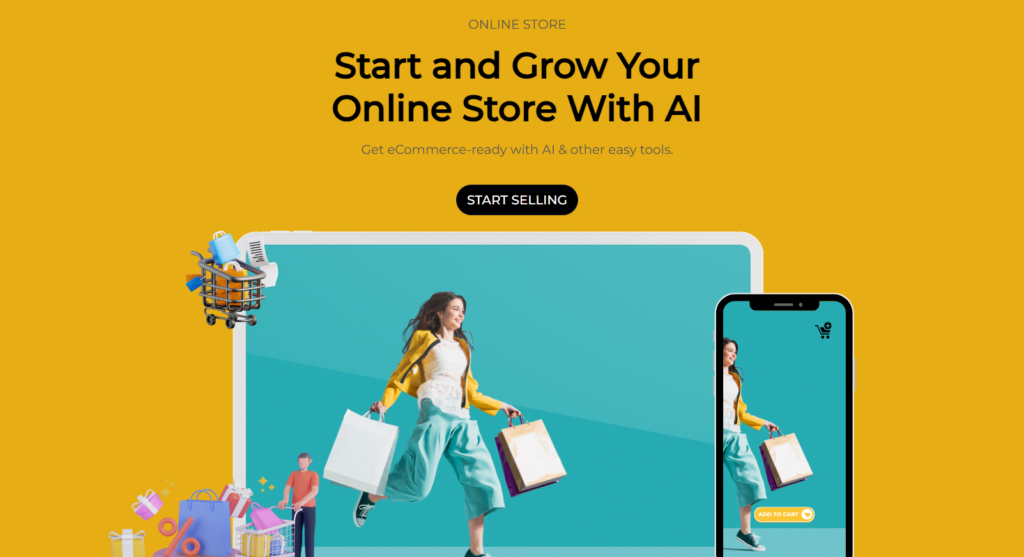Launching a Shopify store is an exciting step toward building your e-commerce empire, but creating the store is just the beginning.
To drive traffic, boost sales, and grow your brand, you need a robust advertising strategy that captures attention and converts visitors into loyal customers.
In this guide, I will outline actionable steps and innovative strategies to promote your Shopify store effectively, blending proven tactics with creative ideas to help you stand out in a crowded digital marketplace.
Why OLITT Could Be Your Shopify Alternative

Before we talk about advertising strategies, consider the foundation of your online store.
Yes, while Shopify is a powerful platform, OLITT offers a compelling alternative for entrepreneurs seeking simplicity, affordability, and flexibility.
OLITT’s drag-and-drop store builder lets you create a stunning, mobile-friendly storefront without coding, and its budget-friendly plans include hosting, domain services, and seamless integrations.
Imagine advertising a store that’s uniquely yours, built with OLITT’s intuitive tools, and designed to convert—pairing perfectly with the creative marketing strategies below to amplify your brand’s reach.
Step 1: First, understand Your Ideal Customer
Effective advertising starts with knowing who you’re talking to.
Research your audience’s demographics, interests, pain points, and online behavior to create detailed buyer personas.
Use Shopify’s analytics or tools like Google Analytics to identify trends in your store’s traffic.
For example, if you sell eco-friendly home goods, your audience might be environmentally conscious millennials who frequent Instagram and value sustainability.
Set Clear Advertising Goals
Establish specific, measurable goals for your campaigns.
Are you aiming to increase website traffic, boost sales for a new product, or build brand awareness?
For instance, a goal like “increase monthly sales by 20% through Instagram ads” gives you a clear target to track.
Creative Idea
Host a “Customer Story Contest” where shoppers share how your product fits into their lives (e.g., a photo of them using your eco-friendly straws). Offer a discount or prize for entries, gathering user-generated content (UGC) to fuel your ads while learning more about your audience.
Step 2: Optimize Your Shopify Store for Conversions
A well-designed store is the backbone of successful advertising.
Ensure your Shopify store is mobile-friendly, fast-loading, and easy to navigate.
Use Google PageSpeed Insights to check load times and optimize images or themes as needed.
A seamless checkout process with multiple payment options reduces cart abandonment.
Use SEO for Organic Traffic
Optimize product pages with relevant keywords, compelling descriptions, and high-quality images.
For example, if you sell handmade candles, use keywords like “soy wax candles” or “aromatherapy candles” in titles, meta descriptions, and alt text.
Shopify’s built-in SEO tools make this process straightforward.
Creative Idea
Add interactive product quizzes powered by apps like Octane.AI.
For instance, a quiz like “Find Your Perfect Candle Scent” engages visitors, recommends products, and captures email leads for future campaigns, boosting both conversions and ad targeting.
Step 3: Build a Multi-Channel Advertising Strategy
Another best way to advertise your Shopify store is to be everywhere, at least.
Social Media Advertising
Social media platforms like Instagram, Facebook, TikTok, and Pinterest are goldmines for Shopify store owners.
Use Shopify’s integrations to create shoppable posts or run dynamic product ads (DPAs) that showcase your catalog.
Target specific audiences based on interests, location, or behavior, and use high-quality visuals to grab attention.
- Instagram Reels: Create short, engaging videos showing your product in action. For a jewelry store, film a “Get Ready With Me” reel featuring your earrings styled for different occasions.
- TikTok Trends: Jump on trending challenges or sounds relevant to your niche. A fashion brand could join a “Y2K Style” trend to showcase retro-inspired clothing.
- Pinterest Ads: Promote lifestyle-focused pins linking to your store, ideal for home decor or wellness products.
For Example
Launch a “Social Media Takeover” campaign where micro-influencers in your niche “take over” your Instagram Stories for a day, sharing authentic content about your products.
This builds trust and exposes your store to new audiences.
Pay-Per-Click (PPC) Advertising
Google Ads, including Google Shopping and search ads, can drive high-intent traffic to your store.
Use Shopify’s Google Channel to sync products and create campaigns.
Focus on long-tail keywords (e.g., “handmade leather journal for travelers”) to target niche shoppers and optimize bids for better ROI.
Idea
Run a “Flash Sale” Google Ads campaign with countdown timers on your landing pages to create urgency. Pair this with remarketing ads to re-engage visitors who didn’t purchase, offering a limited-time discount.
Email Marketing
Email remains a powerhouse for conversions, with an average ROI of $36 for every $1 spent.
Use Shopify Email or apps like Klaviyo to send personalized newsletters, abandoned cart reminders, and post-purchase follow-ups.
Segment your list based on purchase history or behavior for targeted campaigns.
Create a “VIP Insider” email series that offers exclusive sneak peeks, styling tips, or early access to sales.
For a coffee brand, send a weekly “Brew of the Week” email with recipes and a discount code, keeping subscribers engaged.
Step 4: Partner with Influencers
Collaborate with micro-influencers (10K–50K followers) whose audiences align with your brand.
Use Shopify Collabs to connect with creators who can promote your products through authentic content.
For example, a fitness apparel store could send free leggings to yoga influencers for unboxing videos.
Host a “Brand Ambassador Bootcamp” where influencers compete to create the best content featuring your products.
The winner gets a long-term partnership, incentivizing high-quality UGC for your ads.
Set Up an Affiliate Program
Encourage bloggers, creators, and customers to promote your store through affiliate links.
Apps like Refersion or UpPromote make it easy to track commissions. Offer a double-sided reward (e.g., 10% off for both the referrer and referee) to boost participation.
Gamify your affiliate program with a leaderboard showcasing top referrers each month.
Reward them with exclusive products or bonuses, turning affiliates into passionate brand advocates.
Step 5: Start a Blog
Publish SEO-optimized blog posts that provide value to your audience.
For a pet store, write articles like “10 Tips for Training Your New Puppy” or “The Best Eco-Friendly Pet Toys.”
Include CTAs linking to relevant products and share posts on social media.
Here’s an idea:
Create a “Shop the Story” blog series where each post tells a customer’s journey with your product, embedding shoppable links.
For a skincare brand, feature a “Morning Routine” story with your cleanser and moisturizer.
Use Video Content
Videos drive engagement and conversions.
Post product demos, behind-the-scenes clips, or customer testimonials on YouTube, TikTok, and Instagram.
Shopify’s integration with YouTube Shopping lets you tag products in videos.
For example, launch a “Mini-Documentary” video series showcasing the artisans or processes behind your products.
A handmade pottery store could film potters at work, building an emotional connection with viewers.
Read also: How to Change Your Shopify Store Name: A Step-by-Step Guide
Step 6: Reward Repeat Customers
Use apps like Smile.io or LoyaltyLion to create a points-based loyalty program.
Offer points for purchases, reviews, or social shares, redeemable for discounts or exclusive perks.
For example, a beauty store could offer “VIP Samples” for loyal customers.
For instance, introduce a “Loyalty Treasure Hunt” where customers earn bonus points by completing fun tasks, like sharing a post or referring a friend, gamifying the shopping experience.
Encourage Referrals
Set up a referral program with apps like Yotpo, rewarding customers for inviting friends.
A double-sided reward (e.g., $10 off for both parties) motivates participation. Promote the program via email and social media.
Something like: create a “Referral Rally” campaign with a limited-time bonus for top referrers, such as a free product or gift card, sparking excitement and word-of-mouth buzz.
Read also: How to Make Money on Shopify: 11 Ideas and Strategies
Step 7: Track Performance Metrics
Use Shopify’s analytics dashboard to monitor traffic, conversion rates, and sales.
For paid ads, track click-through rates (CTR), cost per click (CPC), and return on ad spend (ROAS).
A/B test ad creatives, landing pages, and email subject lines to find what resonates.
Refine Your Strategy
Based on data, double down on high-performing channels and tweak underperforming ones.
For example, if Instagram ads have a higher ROAS than Google Ads, allocate more budget to social media while optimizing Google campaigns for better keywords.
Creative Idea: Host a “Marketing Lab” webinar for your team, reviewing campaign data and brainstorming new ideas. Invite customers to a live Q&A segment, gathering feedback to refine your approach while building community.
Read also: How to Buy a Domain on Shopify
Creative Campaign Ideas to Stand Out
- Pop-Up Shops in Virtual Reality: Partner with a VR platform to create a 3D pop-up shop where customers can “walk through” your store, interact with products, and make purchases, promoted via social ads.
- Podcast Sponsorships: Sponsor niche podcasts relevant to your audience, offering exclusive discount codes for listeners. For a wellness brand, sponsor a meditation podcast to reach mindful shoppers.
- Interactive Giveaways: Run a social media giveaway where entrants create content (e.g., a short video using your product) for a chance to win. Share the best entries in your ads to boost engagement.
- Augmented Reality Filters: Create branded AR filters on Instagram or Snapchat that let users “try on” your products, like sunglasses or makeup, driving traffic to your store.
Conclusion
Advertising your Shopify store requires a blend of strategic planning, creative execution, and data-driven optimization.
You can drive traffic and sales while building a loyal customer base.
Innovative ideas like quizzes, VR pop-ups, and gamified loyalty programs set your brand apart in a competitive market.
Whether you stick with Shopify or explore OLITT for a fresh, user-friendly store-building experience, the key is to experiment, track results, and keep your audience at the heart of every campaign.
Start small, test bold ideas, and watch your Shopify store thrive.
Read also:

